Google Pixel 3 XL Review
Google Pixel 3 XL Review
One of the most leaked phones ever is finally here
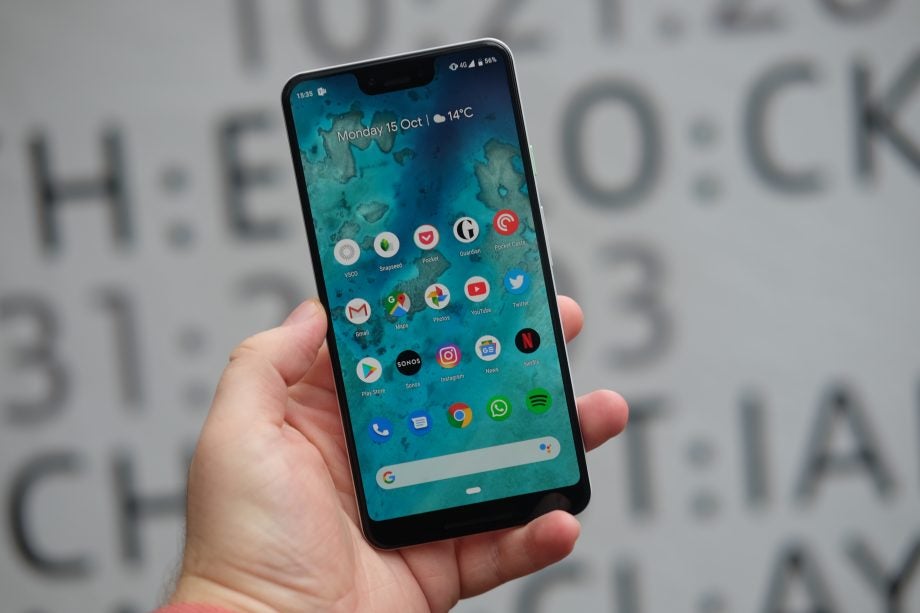
Sections
- Page 1 Google Pixel 3 XL Review
- Page 2 Camera Review
- Page 3 Battery life and Verdict Review
Verdict
A stunning camera makes this one of the smartphones to beat in 2018.
Pros
- Fantastic, colourful display
- The best camera on any phone
- Slick version of Android
- Much-improved design over the Pixel 2 XL
Cons
- Scratches easily
- Some software bugs with the notch
- Battery life not as good as similarly sized rivals
Key Specifications
- Review Price: £869
- 6.4-inch QHD+ display
- Notch
- Snapdragon 845
- 4GB RAM
- Android Pie
- IP68
What is the Google Pixel 3 XL?
The Google Pixel 3 XL was one of the most leaked phones ever. There was little we hadn’t already seen when Google finally announced its 2018 flagship. It also happens that the device itself is quite predictable. It packs clean software, a stunning camera and a much improved overall design.
It also features the most intrusive notch I have seen in any phone yet. This notch makes the ones on the iPhone XS and Huawei Mate 20 Pro look positively tiny.
- There’s a new Pixel in town: Read our hands on Google Pixel 3a review
- And an XL version too: Google Pixel 3a XL review hands on
- Google has just announced the Pixel 4 and Pixel 4 XL. For an in-depth look at both phones take a look at our Pixel 4 review: hands on and Pixel 4 XL review: hands on.
Still, get over the notch – along with the software oddities that come with it – and you’ll find a phone with the best camera on the market.
Looking for the smaller Pixel 3? Read our Google Pixel 3 review.
Google Pixel 3 XL price
Google Pixel 3 XL prices start from £869 for the 64GB model and £969 for the 128GB version.
Google Pixel 3 XL – Design
I’ll start with that notch, because it’s really the first thing that catches your eye. I’ve got nothing against notches in general, but the size of the one used here feels a step too far. It droops down noticeably more than an iPhone XS Max and as a result impacts on the content a lot.
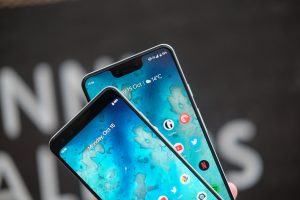
Give it a couple of hours, though, and the notch becomes much less obvious when you’re actually doing stuff. I’m not saying you’ll forget all about it, but in general day-to-day phone use I’m not constantly thinking ‘why is this notch here’.
Of course, the notch is here because of the bigger display, which runs a lot closer to the edge than before. Approaching the design like this means the front cameras – of which there are two here – and speaker need somewhere to sit – and that’s where the notch comes in. It’s a necessary evil for a phone like this.
Related: Best smartphones
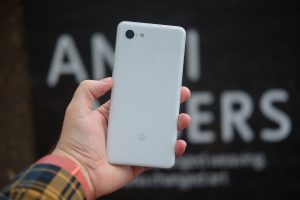
The chin below the display remains and once again this is so there’s enough space for another front speaker.
The back of the Pixel 3 XL is now constructed completely from glass, rather than the mixture of glass and metal Google has utilised before. It makes the phone feel softer and more rounded to hold, plus it allows for Qi wireless charging.
However, after using the phone for a week, the back is already starting to pick up marks and scratches. I’ve seen other users, specifically those with the black version of Pixel 3 XL, with lots of scratches and the same thing seems to be happening with my white review model. The display has also picked up lots of micro-abrasions. With that in mind, I’d suggest picking up a screen-protector and a case to go along with your Pixel 3 XL.
A USB-C port is the single connection here – there’s no 3.5mm headphone jack – and that’s flanked by a SIM card tray on the bottom. Along the right-hand side there’s a volume rocker and power button that, on my white version, has a contrasting greeny/mint colour. This pop of colour is a nice contrast and really catches the eye.
Google Pixel 3 XL – Screen
As good as the Google Pixel 2 XL was, it was severely hampered by a pretty awful display. The LG OLED display used last year received much criticism due to terrible colours and harsh blue shift when it was tilted. A few software updates from Google helped boost the colours somewhat, but the damage was already done.
Thankfully there are no such issues with the 6.3-inch OLED panel here. In fact, I would happily put this alongside the Samsung Galaxy Note 9 and iPhone XS Max as one of the best mobile displays out there.
It packs a 2960 x 1440 (Quad-HD+) panel, full support for HDR playback (currently limited to YouTube, but Netflix should be coming soon) and can be tweaked in a number of ways thanks to three screen modes.
Where the Pixel 2 XL suffered with dull colours and terrible viewing angles, the Pixel 3 XL pops with contrast and just the right amount of saturation in brighter colours like red and green. Viewing angles are great too: tilt the phone and there’s no ugly shift to blue.
Related: Best Android phones

At 6.3 inches, this screen is big. It’s comparable to the Samsung Galaxy Note 9 (6.4 inches), Huawei Mate 20 Pro (6.39 inches) and OnePlus 6T (6.41 inches) and that means the phone itself is pretty large – definitely not one for those who have small pockets.
Even though the display is big, this isn’t the best phone for media viewing – simply because that notch does get in the way. Some apps, YouTube and Netflix for example, can give you the option to expand video behind the notch or default it to 16:9. However, Google Play Movies has no such option, even though it’s visible on the smaller Pixel 3, so movies play in a small box with lots of wasted space.
Google Pixel 3 XL – Performance
More so than even Apple, Google doesn’t talk much about specs when it launches new phones. It prefers to create a story around how the device works, rather than playing up the speed improvements in the processor or amounts of RAM.
All the internal specs are what you would expect from a 2018 flagship phone: Snapdragon 845, 4GB RAM and 64GB of non-expandable storage with a 128GB model available for a bit of extra cash. There’s also a secure Titan chip that’ll store your biometric details and passwords.
As I mentioned in the Google Pixel 3 review, 4GB of RAM does seem a bit stingy when there are plenty of phones with 6 or 8GB. During my time with the Pixel 3 XL, though, I haven’t encountered any issues with performance, in fact it’s been pretty much the opposite. Like previous Pixels, this a very fast phone in terms of everything from opening apps to playing games. I’d go as far as to say it feels like the fastest Android out there and there’s no overlong animations like you’ll find on Samsung phones when opening an app or multitasking.
The real test of a phone like this isn’t how well it performs over a week or two – even the cheapest of phones start off fast – it’s how fast it stays once hundreds of apps are installed and it’s been in use for 12-18 months.
See the below charts for performance in synthetic benchmark tests.
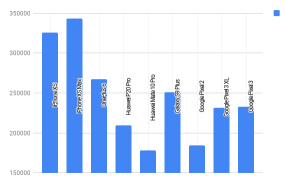
Antutu 7
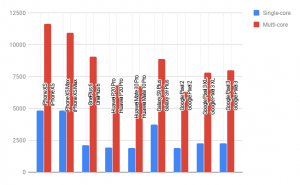
Geekbench 4
A feature often deemed unimportant on Android phones is haptics. This is that small vibration response you get when you tap a key or get a message and the phone is on silent. Normally Android phones have either a really harsh vibration or a weak, shrill one; the Pixel 3 XL has neither. Instead, the vibrations here are strong and short, happening nearly everywhere in the OS. You’ll get a slight buzz when you pull down the notification tray or unlock the phone, and a stronger one when you open the camera. It makes it feel like you’re touching something mechanical and real, rather than just a touchscreen.
One of the biggest reasons why the notch and chins are so prominent here is that they house proper front-firing speakers. As the sound is aimed towards you, it’s not blocked by hands when you’re watching a video. Sound quality from these speakers is excellent, easily up there with the iPhone XS Max and Razer Phone. Sound is bit bassier and fuller than the iPhone XS and it’s loud enough to hear Google Assistant queries from across the room. Whether or not having great sound warrants the large notch will depend on your preferences, but i’ll take it.
There’s no headphone jack here on either of the Pixel 3 phones this year, but Google does include both a 3.5mm headphone jack adaptor and a pair of actually very decent USB-C earbuds in the box.
These earphones are a lot like the wireless Pixel Buds from last year and they boast some of the same translation functionality and Google Assistant tricks. They also have the same looping design whereby the cable wraps around the buds and offers some extra support for the ear. Sound from these USB-C headphones is better than other pack-in options, with decent bass and volume.
There’s Bluetooth 5 support too, if you’re more a fan of wireless headphones, and connection was rock-solid during the review process.
Fingerprint authentication remains the single biometric feature on the Pixel 3 XL and I do miss unlocking the phone with my face. It had become natural to open the iPhone XS by looking at it, and going back is kind of a pain.
Google Pixel 3 XL – Software
The Google Pixel 3 XL runs the latest version of Android 9 Pie with the exclusive Pixel launcher on top. This launcher adds in bits like the swipe-up app tray, gesture buttons and the adaptive time/weather widget.
The UI is clean, simple and fast to navigate. There’s only the essential Google apps pre-installed and absolutely nothing else. As a user of Google services, the way everything works and syncs together is nothing short of fantastic.
Google’s version of Android is the best version for me and I always forgot how great the experience is when I am using something with a heavy skin.
However, I do think a bit more work needs to be done to address the awkwardness of the notch. I’m not talking about having an option to hide the notch with a faux border (you can do this, but it’s hidden away in the developer options), but the way icons and apps interact with. Far too often the status bar icons get stuck behind the notch, meaning you can’t see what’s happening. It just looks weird and unfinished.
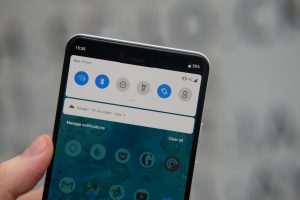
You can even see the tip of the notch intruding on the notification panel
We’ve covered the biggest Android 9 Pie features in a separate piece, so I won’t go deep into them here. However a couple do deserve a mention.
I’m a big fan of the Digital Wellbeing features; being able to set timers on social-media apps and limit how much time I spend scrolling through Instagram is a great addition. I also really like how you can set the screen to black and white after, say, 11pm.
The new gesture navigation controls are here in full force and it seems like, currently, you can’t go back to the old ‘menu, home and overview’ layout. Instead you’ve got a pill-shaped home button that bring up your apps with a swipe and a ‘back’ button that only appears when it’s needed. I do like this gesture-based navigation, but it’s nowhere near as intuitive as the iPhone XS. Too many times I found myself needing two distinct swipes to reach my apps and it’s a pain to quickly jump back to previously used apps. The idea is great, but the way it works needs some tweaking.
How we test phones
We test every mobile phone we review thoroughly. We use industry standard tests to compare features properly and we use the phone as our main device over the review period. We’ll always tell you what we find and we never, ever, accept money to review a product.


